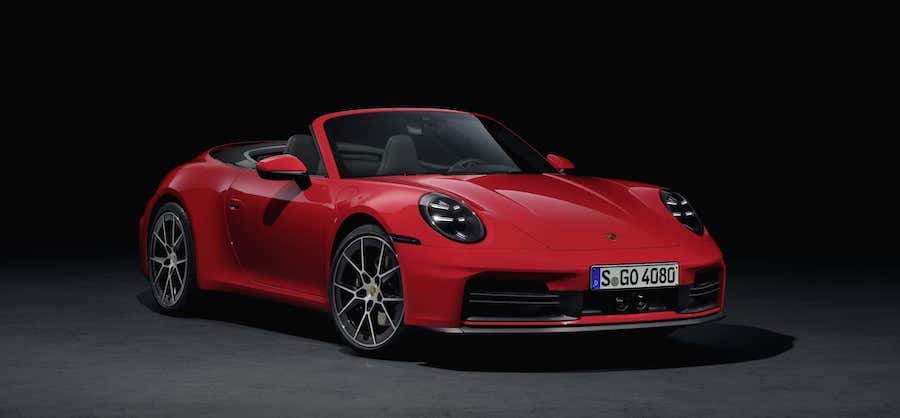2025 Porsche 911 Facelift Goes Live, 992.2 GTS Debuts New Engine With Hybrid Assistance

But first, let us talk exterior styling. The easiest way of telling the 992.2 apart from the first phase of the 992 generation is looking at the most celebrated European sports car from up front. LED matrix headlights are standard, with said headlights incorporating the front driving lights. The reason why Porsche bundled every front lighting function in the headlights is rather simple: better cooling.
Larger cooling vents are joined by active cooling flaps in the lower part of the front bumper. These flaps work together with adaptive front diffusers in the underbody. Porsche claims the system works in two ways: either directing more air to the radiators when power demand is high and sustained (i.e., track driving) or improving aero for efficiency.
Out back, revisions include the aerodynamic diffuser, spoiler, and OLED taillights. Coupe versions of the 911 Carrera and 911 Carrera GTS can be further enhanced – both visually and aerodynamically – with the SportDesign aero kit. Said package comprises a sportier front bumper with a specific front spoiler, matching panels for the side sills, and – of course – a fixed rear wing.
How much of a difference does the aerodynamic package make over the standard specification? As far as the Carrera GTS is concerned, Porsche waxes lyrical about 10 kilograms (22 pounds) of downforce at 194 miles per hour (312 miles per hour) instead of 30 kilograms (66 pounds) of lift.
Hopping inside reveals little in the way of changes from the 992.1 series. A two-seater by default or a 2+2 by choice at no extra charge, the 992.2 flaunts the engine start button on the left side of the steering wheel. The red button on the right side is for drive modes. The pre-facelift Neunelfer's analog tachometer has been swapped out in favor of a completely digital instrument cluster, whereas the high-definition touchscreen on the right features hybrid-specific displays in the case of the Carrera GTS.
Between the 10.9-inch touchscreen and central air vents, you'll find a total of five toggle switch-style buttons, of which the central button is for the hazard lights. Lower still, the toggle switch-like gear selector is accompanied by a few more buttons for the HVAC system. Porsche has also made a case for a cooled compartment with an inductive charging function in the center console for your smartphone.
Apple CarPlay and Siri need to be highlighted, as well as video streaming while parked. Apple Music and everyone's favorite Spotify can be used without connecting your iPhone through Apple CarPlay to the Porsche Communication Management system.
Available on debut in Coupe, Cabriolet, and Targa body styles in Carrera, Career S, and Carrera GTS flavors, the 992.2 carries a starting price of $120,100 in the United States for the 911 Carrera Coupe. Until the facelifted Turbo range and GT2 RS come along, the Cabriolet- and Targa-bodied Carrera 4 GTS serve as the most expensive 992.2s available to order, with both starting at $186,000.
Rear-axle steering is newly standard on the Carrera GTS, whose list of party tricks includes anti-roll stabilization integrated into the performance hybrid system's 400-volt electrical system. From the Carrera to the Carrera GTS, the 992.2 boasts no fewer than seven wheel designs ranging between 19s with 20s to 20s with 21s. Porsche Exclusive Design wheels with carbon blades are available.
Sitting on 8.5" and 11.5" wide wheels, the Carrera GTS is – without a shadow of a doubt – the star of the 992.2 series (thus far, at least) due to its hybridized 3.6-liter boxer engine. It's a single-turbo affair, whereas the Carrera soldiers on with the 3.0L twin-turbocharged boxer we all know and love from the first phase.
The Carrera's six-cylinder lump cranks out 394 ps and 450 Nm (388 hp and 332 lb-ft), meaning 3.9 seconds to 100 clicks (62 miles per hour) with the optional Sport Chrono Package. Without the T-Hybrid system, the new 3.6er in the Carrera GTS makes 485 ps and 570 Nm (478 hp and 420 lb-ft).
Said engine uses an electric turbocharger, which works in a similar fashion to a regular turbo, except for a small electric motor that minimizes turbo lag. Powered by a 1.9-kWh battery that eats into the front trunk's cargo volume, the traction motor is located within the front section of the PDK transmission. It assists the engine with 54 horses and 150 Nm (make that 111 pound-feet of torque).
50 kilos (110 pounds) heavier than the pre-facelift 911 Carrera GTS, the newcomer is rated at 541 ps and 610 Nm (534 hp and 450 lb-ft), which makes the facelifted Carrera GTS more powerful than the pre-facelift GT3 RS. Porsche quotes 3.0 seconds for the dash to 62 miles per hour, 10.5 seconds to 124 miles per hour (200 kilometers per hour), and one more MPH in top speed versus the pre-facelift.
The 919 endurance racer-derived hybrid setup is designed to produce energy at all times, not only during braking. The T-Hybrid system is obviously compatible with four-wheel drive, and naturally, the Carrera 4 GTS is hybrid as well. It remains to be seen, though, if the Turbo and GT2 RS will follow in the footsteps of the hybridized Carrera GTS and Carrera 4 GTS.
Nouvelles connexes


